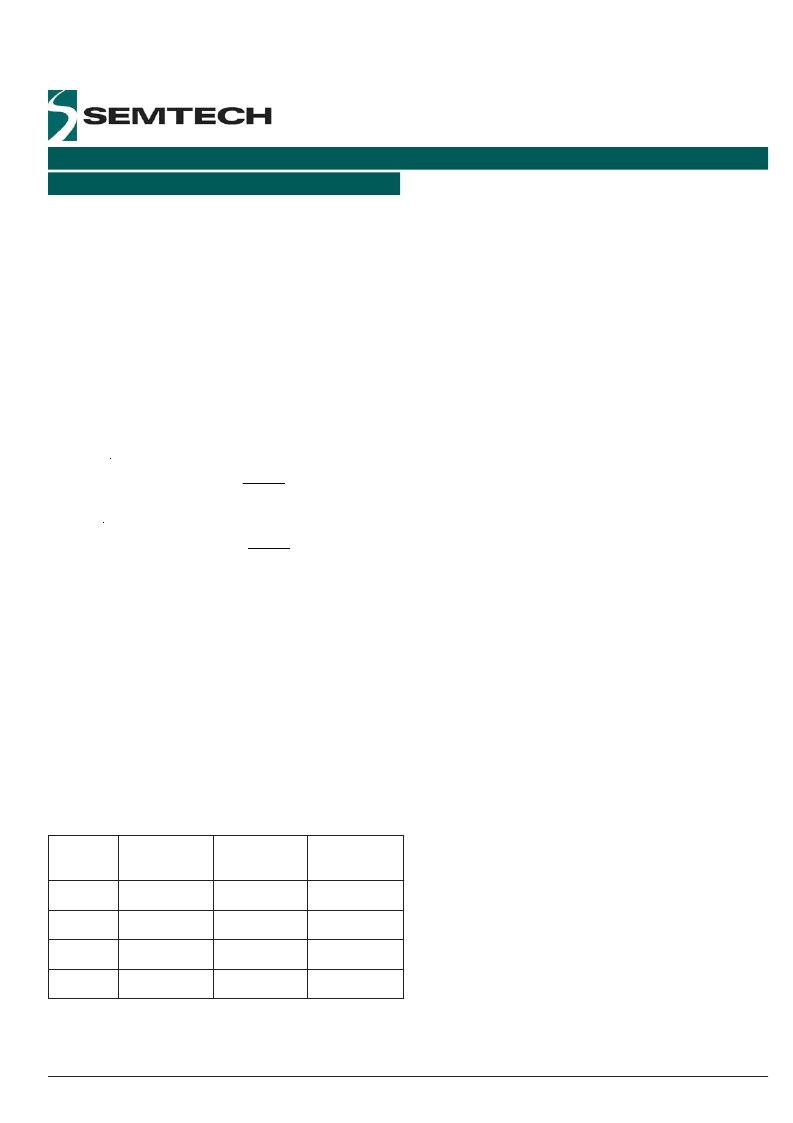- 您現在的位置:買賣IC網 > PDF目錄374735 > SC802A (Semtech Corporation) Fully Integrated Lithium-Ion Battery Charger System with Timer PDF資料下載
參數資料
| 型號: | SC802A |
| 廠商: | Semtech Corporation |
| 英文描述: | Fully Integrated Lithium-Ion Battery Charger System with Timer |
| 中文描述: | 完全集成的鋰離子電池充電器系統(tǒng)的計時器 |
| 文件頁數: | 8/16頁 |
| 文件大小: | 484K |
| 代理商: | SC802A |

8
2005 Semtech Corp.
www.semtech.com
SC802/SC802A
POWER MANAGEMENT
ApplicationsPrelimi-
Termination Current
Once the battery reaches the program voltage of 4.1V,
4.2V or externally set voltage, the device will transition
from a constant current source to a constant voltage
source. The current through the battery begins to de-
crease while the voltage remains constan until it falls
below the programmed termination current set by the
termination resistor on the ITERM pin. The SC802 will
turn off the CHRGB Led. If the timer is enabled the out-
put will continue to float charge in CV mode until the
timer expires. If the timer is disabled than the output will
turn off as soon as the termination current level is
reached. The equation for setting the the termination
current
Charge Timer
The timer on the SC802 is used as protection in the case
of a faulty battery and to maximize charging capacity. Tie
the RTIM pin to VCC to select the internal timer, GND to
disable the timer. Connecting a resistor between RTIM
and GND will program the total charge time according to
the following equation with the charge time expressed in
hours.
=
Q
Total
RTIM
Ω
×
12.5k
Time
The timer is programmable over the range of 2 to 6hrs.
The internal timer selection results in a charge time of
3hrs. The CHRGB blink rate in fault condtions is a func-
tion of the timer setting when an external RTIM is used.
The SC802 will automatically turn off the output when
the charge timer times out.
LDO Mode
The SC802 is designed to work with or without a battery.
If the battery is not in place the device can enter the
LDO mode. In this mode the SC802 will act like a low
dropout regulator. The output voltage is set to 4.1V, 4.2V
or externally set by a resistor divider. See the section
titled “Configuring the output voltage to the battery” for
setting an output voltage. The input pin BIPB (Battery In
Place Bar) is used to switch the SC802 from charger
mode to LDO mode. If this pin is logic high the device will
be in LDO mode, if it is logic low it will be in the charger
mode. During LDO mode the device will regulate the out-
put voltage with a current limit set by the resistor tied to
the IPRGM pin. The BIPB pin should never be left float-
ing. It should be tied through pull-up/pull-down resistors
when connected to a high impedance control pin or it
can be connected directly to the VCC pin or GND.
EN-NTC Interface
The Enable pin on the SC802 provides two functions. It
can be used to turn on/off the device by driving it to
VCC/Ground. It can also be connected to an external
resistor divider consisting of a resistor and an NTC Ther-
mistor to disable the charge cycle when the temperature
is out of range. This configuration is shown in the typical
application schematic on page 1 of the datasheet. When
the NTC voltage from the divider is above or below the
hot and cold temperature threshold values the SC802
will suspend the charge cycle by turning off the output,
freezing the charge timer, and indicating a fault on the
CHRGB LED. Hysteresis is included for both thresholds
to avoid chatter at the NTC trip points. When the tem-
The termination current is programmable up to 67mA
for the SC802. The termination current is programmable
up to 150mA with VCC=5V on the SC802A.
Monitor Mode
When a charge cycle is completed, the SC802 output
turns off and the device enters monitor mode. If the
voltage of the battery falls below the recharge threshold
of CV-100mV the charger will clear the charge timer and
re-initiate a charge cycle. The maximum current drain of
the battery during monitor mode will be no more than
1uA over temperature. The status of the charger output
as a function of BIPB, Timer, and IOUT is shown below.
t
u
e
p
t
t
a
u
t
O
S
B
P
I
B
r
e
m
i
t
u
o
n
O
h
g
A
/
N
A
/
N
n
O
w
o
L
r
m
i
<
T
A
/
N
f
O
w
o
L
r
m
i
>
T
A
/
N
f
O
w
o
L
d
e
a
s
n
o
n
m
r
<
88
×
R
1.5
ITERM
SC802
TERM
=
97
×
R
1.5
ITERM
SC802A
TERM
=
相關PDF資料 |
PDF描述 |
|---|---|
| SC802AIMLTRT | Fully Integrated Lithium-Ion Battery Charger System with Timer |
| SC802EVB | Fully Integrated Lithium-Ion Battery Charger System with Timer |
| SC802IMLTR | Fully Integrated Lithium-Ion Battery Charger System with Timer |
| SC802IMLTRT | Fully Integrated Lithium-Ion Battery Charger System with Timer |
| SC803 | Fully Integrated High Current Lithium-Ion Battery Charger System |
相關代理商/技術參數 |
參數描述 |
|---|---|
| SC802AEVB | 制造商:SEMTECH 制造商全稱:Semtech Corporation 功能描述:Fully Integrated Lithium-Ion Battery Charger System with Timer |
| SC802AIMLTRT | 制造商:Semtech Corporation 功能描述:Constant Current/Voltage Charger Li-Ion/Li-Pol/NiCD/NiMH 1000mA 4.2V/4.1V 16-Pin MLP EP T/R |
| SC802B | 制造商:未知廠家 制造商全稱:未知廠家 功能描述:LCD module |
| SC802EVB | 制造商:SEMTECH 制造商全稱:Semtech Corporation 功能描述:Fully Integrated Lithium-Ion Battery Charger System with Timer |
| SC802IMLTR | 制造商:SEMTECH 制造商全稱:Semtech Corporation 功能描述:Fully Integrated Lithium-Ion Battery Charger System with Timer |
發(fā)布緊急采購,3分鐘左右您將得到回復。